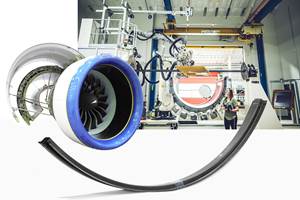RMX Technologies to commercialize plasma surface treatment technology
After developing a plasma-based technology for carbon fiber oxidation, RMX Technologies is targeting plasma-based surface treatment technology.

The carbon fiber pilot production line at Oak Ridge National Laboratories
(ORNL, Oak Ridge, Tennessee) has provided fertile ground for the development of technologies that are helping make carbon fiber manufacture more efficient and less expensive. (Photo from Harper International – Pilot Line in operation at ORNL)
RMX Technologies (Knoxville, Tennessee) has been selected by the U.S. Department of Energy (DOE) to proceed with commercialization of its patented plasma surface treatment (PST) technology, working with ORNL and C. A. Litzler.
This project is in addition to work RMX Technologies already has in process regarding use of its plasma oxidation in carbon fiber manufacture. The plasma oxidation technology is expected to reduce oxidation energy consumption during carbon fiber manufacture by as much as 75%, and overall carbon fiber production costs by 20%.
Surface treatment is the third major step in carbon fiber production and plasma surface treatment will allow customers to modify the surface of carbon fiber so that less expensive plastics can be used to make parts. This technology should also allow parts makers to use less fiber per part which also reduces the cost of parts. In addition to those benefits the technology could replace a wet chemistry process that produces much more waste and is inherently more troublesome.
CW spoke with Truman Bonds, vice president of R&D at RMX, about the technology:
CW: How does the plasma technology function to treat the fiber surface? Is it used in conjunction with chemicals or compounds?
Bonds: Yes. The user would have the ability to apply unique chemical functionality on the fiber surface. The process is in the gas phase and the combination of feed gas and plasma chemistry achieves the desired effect.
CW: Does the plasma system allow for the application of different types of surface treatment? If so, how?
Bonds: Yes. An advantage of plasma surface treatment over traditional wet bath methods is flexibility. The user can rapidly change the type of surface treatment in the control interface by switching feed gases and plasma conditions. These changes could be pre-programmed and plumbed in so the switch is easy and fast.
CW: You mention that this system allows carbon fiber to be treated/sized for use with “less expensive plastics.” What types of plastics do you mean? Commodity thermoplastics?
Bonds: In general we are referring to the new low-cost resins the automotive industry is interested in. One of the goals of this project is to demonstrate which materials work the best. Nevertheless, since the PST method is so flexible, it is only a matter of finding the right combination of feed gases, plasma conditions and new sizings to achieve strong bonds with a particular resin.
CW: What will be involved in the commercialization effort?
Bonds: Our goals:
Technical
- Design and build the PST unit
- Examine both oxidative and non-oxidative surface chemistry functionalization.
- Examine surface roughening effects.
- Establish mechanical and chemical fiber surface modifications’ effects on composite part strength.
- Determine optimal process for select sizing and resin chemistries.
Commercial
- Obtain commitments from existing carbon fiber manufacturers to process their carbon fiber in the plasma surface treatment unit
- Sell plasma surface treatment units to these companies for pilot lines and eventually production lines.
- Sell plasma surface treatment units downstream users of carbon fiber that require specific surface treatment chemistries.
CW: What is the commercialization timeline?
Bonds: The project we proposed is 18 months, the end of which we will have an operational unit at the 1-ton/year scale, matching the throughput of our 1-ton plasma oxidation device. After that, we can scale much more quickly to industrial levels than plasma oxidation scaling, as the equipment is much smaller.
CW: Is C. A. Litzler building the equipment for this, just as they have for the oxidation technology?
Bonds: As with plasma oxidation, Litzler will build the conventional structures and components and RMX will build the plasma components and integrate it.
Related Content
Low-cost, efficient CFRP anisogrid lattice structures
CIRA uses patented parallel winding, dry fiber, silicone tooling and resin infusion to cut labor for lightweight, heavily loaded space applications.
Read MoreBladder-assisted compression molding derivative produces complex, autoclave-quality automotive parts
HP Composites’ AirPower technology enables high-rate CFRP roof production with 50% energy savings for the Maserati MC20.
Read MoreThe potential for thermoplastic composite nacelles
Collins Aerospace draws on global team, decades of experience to demonstrate large, curved AFP and welded structures for the next generation of aircraft.
Read MoreWelding is not bonding
Discussion of the issues in our understanding of thermoplastic composite welded structures and certification of the latest materials and welding technologies for future airframes.
Read MoreRead Next
Ultrasonic welding for in-space manufacturing of CFRTP
Agile Ultrasonics and NASA trial robotic-compatible carbon fiber-reinforced thermoplastic ultrasonic welding technology for space structures.
Read MoreScaling up, optimizing the flax fiber composite camper
Greenlander’s Sherpa RV cab, which is largely constructed from flax fiber/bio-epoxy sandwich panels, nears commercial production readiness and next-generation scale-up.
Read MoreNext-gen fan blades: Hybrid twin RTM, printed sensors, laser shock disassembly
MORPHO project demonstrates blade with 20% faster RTM cure cycle, uses AI-based monitoring for improved maintenance/life cycle management and proves laser shock disassembly for recycling.
Read More












